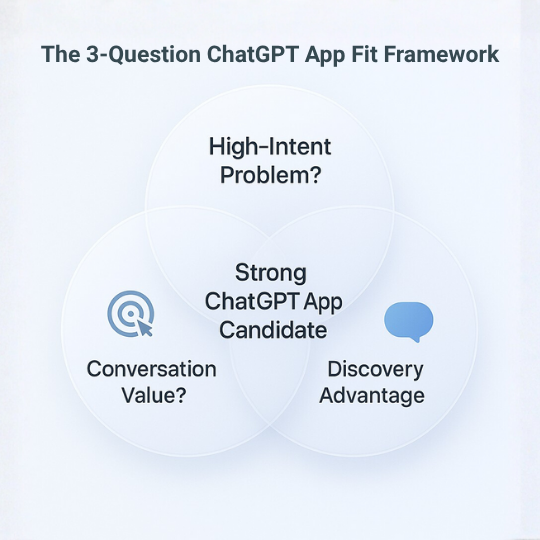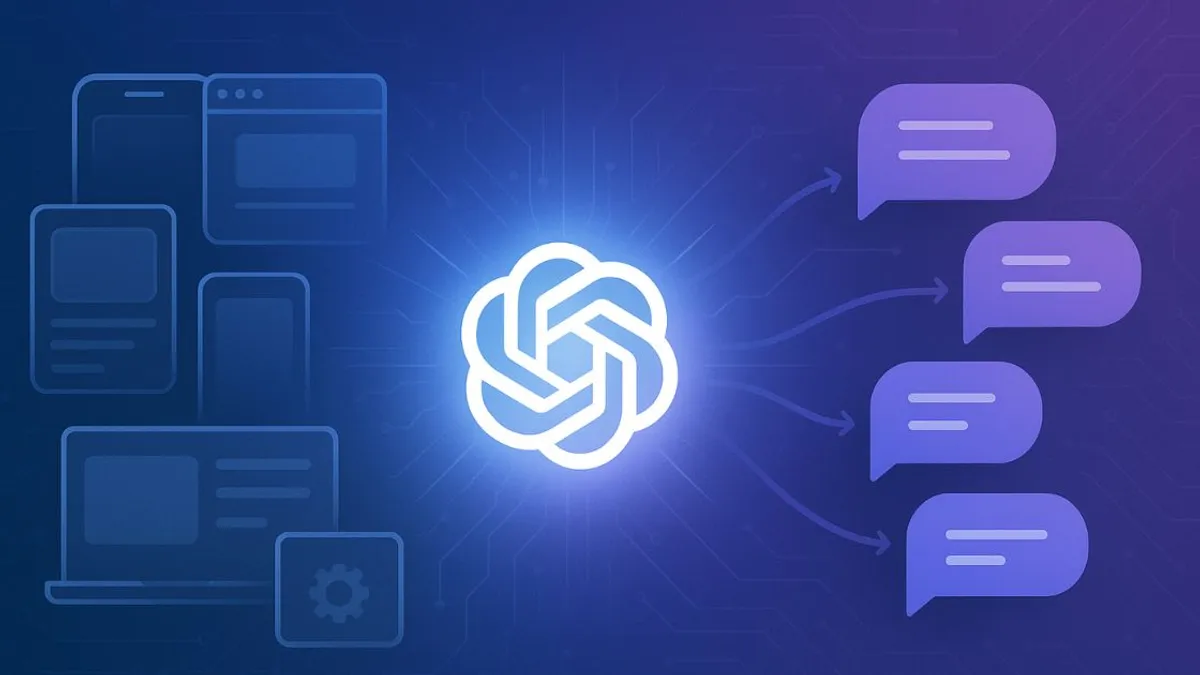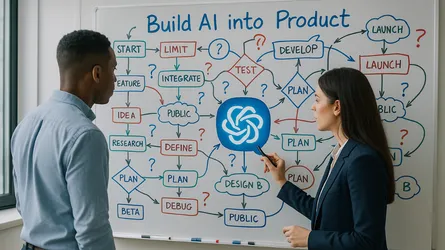Your competitor just announced a ChatGPT app integration. Your CEO forwarded you the press release with “Thoughts?” in the subject line. Now you’re Googling “ChatGPT app strategy” at 11 PM, trying to figure out if this is the next mobile app moment—or just another AI hype cycle. The problem? Most articles either hype the opportunity without practical guidance or dive into technical implementation before answering the strategic question: Should you even build one?
The Platform Shift No One’s Talking About
Here’s what’s actually happening: ChatGPT is becoming an operating system for interaction, and most product leaders are missing it.
When someone types “Help me plan a wedding” or “Find a cemetery plot near me” into ChatGPT, apps surface natively in the conversation—bypassing Google search, bypassing your website, bypassing your entire traditional acquisition funnel. High-intent queries that used to drive SEO traffic now trigger ChatGPT apps directly.
The cost of ignoring this:
- Your competitors establish category presence while you evaluate
- High-intent users discover alternative solutions inside ChatGPT
- You miss the algorithmic and editorial selection window (it’s like early App Store rankings)
- By the time you move, you’re building in a crowded space
Companies like Booking.com, Canva, and Zillow aren’t experimenting—they’re claiming territory. And just like early SEO winners and mobile app pioneers, early builders in the ChatGPT ecosystem are winning visibility that will be exponentially harder to achieve in 12 months.

The Three Questions Every Product Leader Should Ask
Key Principle: Not every product belongs in a conversational interface—and that’s perfectly fine.
The companies winning with ChatGPT apps aren’t building because they can. They’re building because their products fundamentally solve high-intent problems through conversation. Before you commit engineering resources or roadmap space, run your product through this three-question filter.
1. Does Your Product Solve High-Intent Problems?
ChatGPT apps excel when users have urgent, specific needs. “Find me a cemetery plot” is high-intent. “Browse vacation ideas” is exploratory.
If your product answers “I need X now” queries, you’re in the sweet spot. If your product is built for casual browsing or long-term research, conversational interfaces might not be your primary channel.

Examples of high-intent products:
- Travel booking (progressively narrow options through dialogue)
- Legal document generation (guide users through complex decisions)
- Technical troubleshooting (diagnose issues conversationally)
- Event planning services (ask clarifying questions naturally)
2. Can You Deliver Value Conversationally?
Some products require complex visual interfaces. Video editing tools, design software, and data visualization platforms need traditional UIs.
But if your core value comes from helping users make decisions, generate outputs, or navigate complex processes through guided interaction? You’re a strong candidate.
ChatGPT’s new SDKs enable visual-rich mini-UIs within chat. Think Zillow-style property cards or Canva-style template previews—conversational and visual.
Ask yourself: Can users get meaningful value from our product through back-and-forth dialogue, or do they need extensive visual control?
3. Does ChatGPT Discovery Beat Traditional Channels?
For established brands with strong SEO and direct traffic, ChatGPT apps are complementary. For niche SaaS tools and specialized services, ChatGPT apps could be transformational.
If your product solves problems users don’t know how to search for on Google, ChatGPT’s conversational discovery is your advantage. Users describe problems naturally, and your app surfaces at the exact moment of need.
First-mover advantage is strongest here: Less competition for intent-matching, better algorithmic selection, earlier brand association with use cases.
The companies winning with ChatGPT apps aren’t building because they can—they’re building because their product fundamentally solves high-intent problems through conversation.
How to Build Your ChatGPT App Strategy This Week
Most product leaders think building ChatGPT apps requires AI expertise and months of development. Reality? You need clear product logic and 2-4 days for an simple MVP.
Step 1: Map Your High-Intent Features
List your top 5 product features. For each one, answer:
- What urgent problem does this solve?
- Can users explain this need conversationally?
- Would ChatGPT users discover this better than through search?
What you’ll get: Clarity on which features are ChatGPT app candidates (and which aren’t).

Step 2: Prototype the Conversation
Pick your strongest candidate feature. Write out the ideal conversation flow:
- User describes their need
- Your app asks clarifying questions
- App delivers value (answer, generated output, booking, etc.)
Don’t code anything. Just map the dialogue. If it feels natural and valuable, you’ve validated the concept.
What you’ll get: Proof that your feature translates to conversational interaction—or evidence it doesn’t (saving you wasted development time).
Step 3: Review OpenAI’s Documentation
Head to OpenAI’s ChatGPT app documentation. You’ll discover:
- Most apps are API integrations (if you have existing APIs, you’re 80% there)
- You don’t need AI expertise—you need clear function definitions
- Authentication and data flow are straightforward
What you’ll get: Realistic assessment of development effort. Spoiler: It’s often simpler than you think. One developer, 2-4 weeks for a focused MVP.
Two Strategic Plays for Different Business Models
Product Builders: Monetize Directly or Indirectly
Build SaaS-style utilities directly into ChatGPT. Monetization options:
- Direct: API usage fees, premium feature subscriptions
- Indirect: Lead generation, freemium conversion funnel
- Hybrid: Free basic features, paid advanced capabilities
The key insight? ChatGPT apps don’t replace your product—they become a new acquisition channel and a new interface for existing functionality.
Service Providers: Own Your Category Intent
If you provide high-intent services (estate planning, event management, technical consulting), ChatGPT apps let you own the conversational moment.
When users describe their problem naturally, your app surfaces as the solution. This is category ownership at the point of need—the way Google search used to work, but more targeted.
The Future is Chat-Native
Here’s the uncomfortable truth: websites are becoming redundant for many use cases. The future interface is a multi-modal assistant that understands context, remembers preferences, and delivers value through conversation—not a content archive users have to navigate.
If your product isn’t easy to explore through chat (with logic and visuals), you’re not just behind on ChatGPT apps. You’re behind on where software interfaces are heading.

If your product isn’t easy to explore through chat (with logic and visuals), you’re not just behind on ChatGPT apps. You’re behind on where software interfaces are heading.
Start building your “Chat UI strategy” now—not because ChatGPT apps are hyped, but because conversational interfaces are the next evolution of how users interact with software.
The companies that figure this out in 2026 will have the same advantage early mobile app builders had in 2010. The companies that wait? They’ll be building in a saturated market, fighting for scraps of attention.
The platform shift is happening. The question isn’t whether conversational apps will matter—it’s whether you’ll be early or late.
Ready to Evaluate Your ChatGPT App Opportunity?
📞 Free Strategy Assessment: We’ll review your product’s ChatGPT app potential and provide a customized roadmap. No sales pitch—just strategic clarity.


